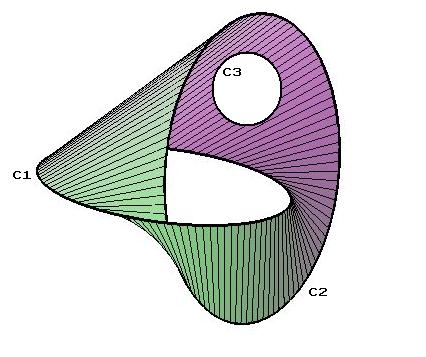link (knot theory) on:
[Wikipedia]
[Google]
[Amazon]
In 
mathematical
Mathematics is a field of study that discovers and organizes methods, Mathematical theory, theories and theorems that are developed and Mathematical proof, proved for the needs of empirical sciences and mathematics itself. There are many ar ...
knot theory
In topology, knot theory is the study of knot (mathematics), mathematical knots. While inspired by knots which appear in daily life, such as those in shoelaces and rope, a mathematical knot differs in that the ends are joined so it cannot be und ...
, a link is a collection of knot
A knot is an intentional complication in Rope, cordage which may be practical or decorative, or both. Practical knots are classified by function, including List of hitch knots, hitches, List of bend knots, bends, List of loop knots, loop knots, ...
s that do not intersect, but which may be linked (or knotted) together. A knot can be described as a link with one component. Links and knots are studied in a branch of mathematics called knot theory
In topology, knot theory is the study of knot (mathematics), mathematical knots. While inspired by knots which appear in daily life, such as those in shoelaces and rope, a mathematical knot differs in that the ends are joined so it cannot be und ...
. Implicit in this definition is that there is a ''trivial'' reference link, usually called the unlink, but the word is also sometimes used in context where there is no notion of a trivial link.
For example, a co-dimension 2 link in 3-dimensional space is a subspace of 3-dimensional Euclidean space
Euclidean space is the fundamental space of geometry, intended to represent physical space. Originally, in Euclid's ''Elements'', it was the three-dimensional space of Euclidean geometry, but in modern mathematics there are ''Euclidean spaces ...
(or often the 3-sphere) whose connected components are homeomorphic
In mathematics and more specifically in topology, a homeomorphism ( from Greek roots meaning "similar shape", named by Henri Poincaré), also called topological isomorphism, or bicontinuous function, is a bijective and continuous function betw ...
to circle
A circle is a shape consisting of all point (geometry), points in a plane (mathematics), plane that are at a given distance from a given point, the Centre (geometry), centre. The distance between any point of the circle and the centre is cal ...
s.
The simplest nontrivial example of a link with more than one component is called the Hopf link, which consists of two circles (or unknot
In the knot theory, mathematical theory of knots, the unknot, not knot, or trivial knot, is the least knotted of all knots. Intuitively, the unknot is a closed loop of rope without a Knot (mathematics), knot tied into it, unknotted. To a knot ...
s) linked together once. The circles in
the Borromean rings
In mathematics, the Borromean rings are three simple closed curves in three-dimensional space that are link (knot theory), topologically linked and cannot be separated from each other, but that break apart into two unknotted and unlinked loops wh ...
are collectively linked despite the fact that no two of them are directly linked. The Borromean rings thus form a Brunnian link and in fact constitute the simplest such link.

Generalizations
The notion of a link can be generalized in a number of ways.General manifolds
Frequently the word link is used to describe any submanifold of thesphere
A sphere (from Ancient Greek, Greek , ) is a surface (mathematics), surface analogous to the circle, a curve. In solid geometry, a sphere is the Locus (mathematics), set of points that are all at the same distance from a given point in three ...
diffeomorphic to a disjoint union of a finite number of sphere
A sphere (from Ancient Greek, Greek , ) is a surface (mathematics), surface analogous to the circle, a curve. In solid geometry, a sphere is the Locus (mathematics), set of points that are all at the same distance from a given point in three ...
s, .
In full generality, the word link is essentially the same as the word ''knot'' – the context is that one has a submanifold ''M'' of a manifold ''N'' (considered to be trivially embedded) and a non-trivial embedding of ''M'' in ''N'', non-trivial in the sense that the 2nd embedding is not isotopic to the 1st. If ''M'' is disconnected, the embedding is called a link (or said to be linked). If ''M'' is connected, it is called a knot.
Tangles, string links, and braids
While (1-dimensional) links are defined as embeddings of circles, it is often interesting and especially technically useful to consider embedded intervals (strands), as in braid theory. Most generally, one can consider a tangle – a tangle is an embedding : of a (smooth) compact 1-manifold with boundary into the plane times the interval such that the boundary is embedded in : (). The type of a tangle is the manifold ''X,'' together with a fixed embedding of Concretely, a connected compact 1-manifold with boundary is an interval